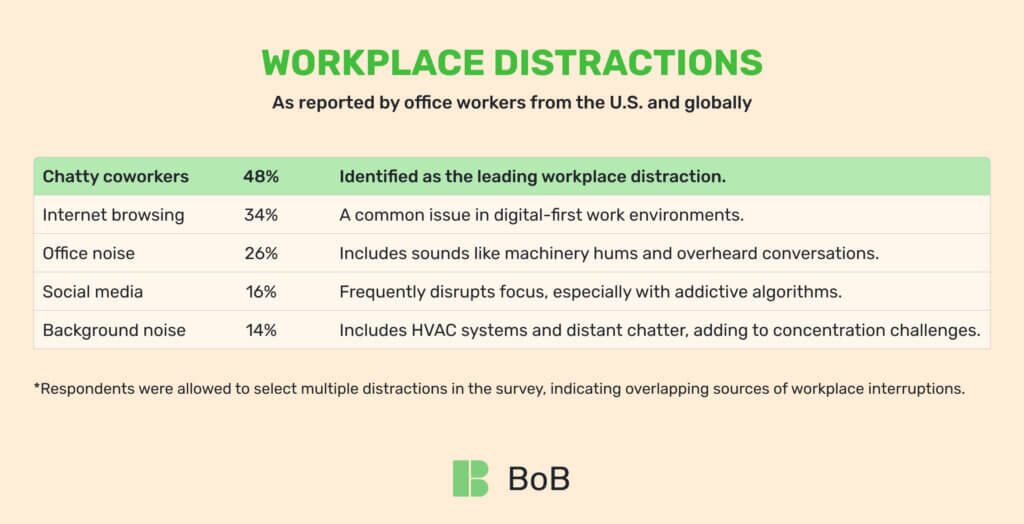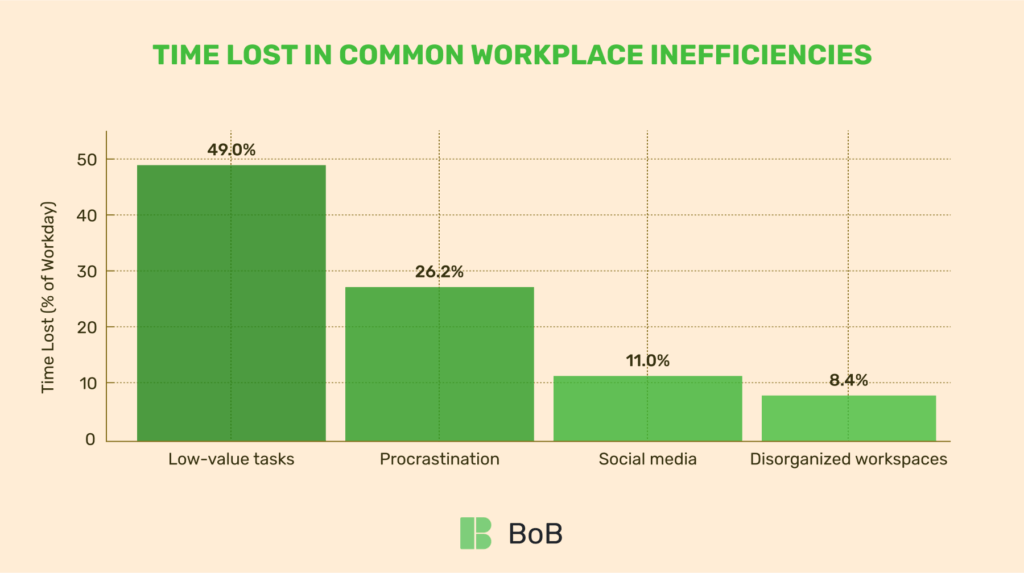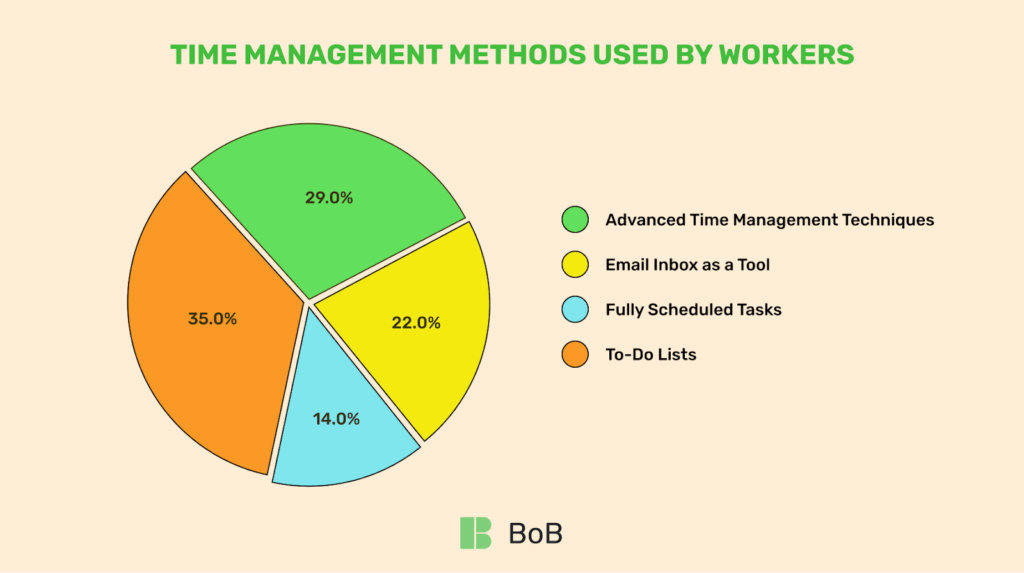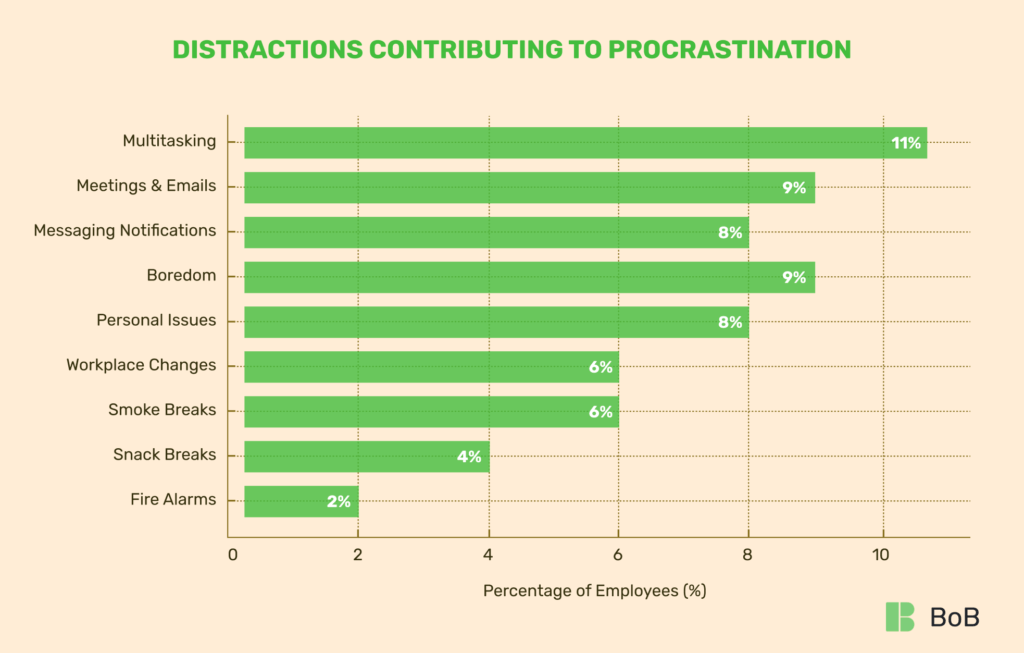Time Management Insights
Time Management Statistics And Facts Everyone Should Know in 2025
This article provides key facts and statistics about time management, based on BeOnBoard’s research and surveys. It explores the habits of office and remote teams, uncovering mental challenges like maintaining focus and preventing burnout. With actionable tips and insights, it helps employees improve productivity and supports managers in building efficient, well-balanced workplaces.

Managing time has become a critical pain point for IT companies, particularly those with U.S.-based headquarters and distributed teams operating across asynchronous time zones. Temporal misalignment and communication bottlenecks often derail workflows, creating ripple effects that hinder project milestones.
Statistics of time management reveal how these issues can escalate without proper strategies in place. For many, the shift to remote work has compounded these challenges—task prioritization and focus maintenance have become key concerns in a home setting filled with ambient distractions and decision fatigue.
Time management stats show that nearly 80% of individuals lack a formalized task management framework, resulting in significant time sinkholes from unstructured workflows. For remote teams, especially those navigating chronemics (the study of time in communication) and digital presenteeism, the struggle is even more pronounced.
However, time management facts suggest that spending just 10 minutes planning your day can recapture up to two hours, emphasizing the importance of adopting techniques like timeboxing and strategic prioritization to stay productive in a fragmented work environment.

Workplace Distractions: Insights from Time Management Statistics
Distractions in the workplace are a persistent challenge. A recent office productivity survey conducted by the BeOnBoard (employee timesheet management software) team revealed that employees lose more than seven hours per week to interruptions.
The survey, which included around 700 office workers in the U.S. and globally, found that 48% of respondents identified chatty coworkers as the primary distraction. Another 34% admitted that internet browsing often disrupts their focus, reflecting the difficulties of maintaining discipline in a digital-first world.
The findings also showed that 26% of employees struggle with noise in the office environment, while 16% are frequently distracted by social media. Background noise—ranging from HVAC systems to distant conversations—was cited by 14% of workers as a recurring obstacle.
These time management facts illustrate how social and environmental factors hinder workplace productivity, with nearly 87% of employees reporting at least one distraction daily.
“If you look closely at time management statistics, it’s clear that tackling workplace distractions isn’t rocket science. Simple steps like cutting down on noise, setting boundaries for digital use, and just getting everyone on the same page can make a world of difference. It’s about creating a space where people can actually focus and get stuff done.”
— Jacob Watt Jr., Director at a law firm using the BeOnBoard system

Where Does Our Productive Time Go?
Almost half of the workday—about 49%—is spent on tasks that bring little to no value. Among the biggest time-wasters are pointless meetings (15%), unnecessary emails (22%), and inefficient commutes (12%), all chipping away at valuable working hours.
Social media also takes a significant toll, with employees spending 11% of their work hours scrolling unproductively. Given that the average person uses social platforms for around 140 minutes daily, it’s no wonder staying focused at work can feel like an uphill battle. Add procrastination—averaging 2 hours and 5 minutes per day—and the picture becomes clear: more than 10 hours a week disappear, leaving just three-quarters of a 40-hour workweek for actual productivity!
Cluttered workspaces contribute as well, costing about 40 minutes daily or 3.3 hours a week in lost time and mental distraction. Searching for misplaced items or attempting to work in a chaotic environment only amplifies stress and blocks focus. Together, these habits reveal just how much of our productive time quietly slips away each day.
| Category | Time Lost Per Day | Time Lost Per Week | Insights |
| Low-value tasks | 49% of the workday | ~20 hours in a 40-hour week | Includes unnecessary meetings (15%), emails (22%), and inefficient commutes (12%). |
| Social media | 11% of work hours | ~4.4 hours | Employees spend an average of 140 minutes daily on social platforms. |
| Procrastination | 2 hours and 5 minutes | ~10.5 hours | Accounts for one-quarter of the standard 40-hour workweek. |
| Disorganized workspaces | ~40 minutes | ~3.3 hours | Time wasted searching for items; adds mental clutter and stress. |

The Hidden Costs of Workplace Distractions
Distractions in the workplace are a silent productivity killer, as facts and statistics about time management reveal. Employees, on average, spend just 12 minutes on a task before an interruption occurs, and regaining focus afterward can take over 23 minutes. Nearly 90% of U.S. workers report being interrupted daily, with 25% experiencing six or more disruptions—a pattern that drastically diminishes efficiency and task throughput.
The consequences are staggering:
- 1 hour and 18 minutes lost daily per worker, equating to nearly 340 hours annually.
- Workplace distractions cost U.S. businesses an estimated $650 billion annually.
- Task interruptions lead to cognitive load increase, reducing work precision and quality.
- Time fragmentation from frequent disruptions contributes to higher stress and burnout rates.
- Compensatory work by colleagues adds to the organizational inefficiency and labor imbalance.
Our findings reveal that 62% of respondents require around 10 minutes to restore their cognitive flow after an interruption. Another 19% take up to 30 minutes, while 13% spend as much as an hour reestablishing their mental momentum.
These recovery periods, driven by the need to reset working memory and reduce task-switching fatigue, result in workers losing nearly an hour per week to what experts call re-attention latency—a hidden drain on productivity.
“Dealing with distractions isn’t just about saving time—it’s about protecting the team’s energy and focus. Whether it’s smarter task batching, cutting down noise, or using attention management frameworks, these small changes add up. In the long run, they’re what help businesses stay efficient and sustainable.”
— Lisa C., CTO at an IT company in Los Angeles using BeOnBoard for team billing
Effective Time Management Statistics: Methods That Workers Use
Time management isn’t a one-size-fits-all concept. People often experiment with various strategies, searching for the one that matches their cognitive style and workload. This trial-and-error approach is reflected in effective time management statistics, which reveal that only 14% of workers fully schedule their tasks in advance, while the majority take a reactive approach to their day. Below are some of the most impactful time management methods, each offering unique principles to help individuals reclaim lost time:
- Eisenhower Matrix: A decision-making framework that categorizes tasks based on urgency and importance. Tasks in the “important and urgent” quadrant take priority, while less critical items are scheduled, delegated, or eliminated. This approach reduces decision fatigue and helps maintain focus on high-impact activities.
- Time Blocking: This method turns your schedule into a visual roadmap by assigning blocks of time for specific tasks. Time blocking integrates concepts like deep work and minimizes context switching, allowing for more concentrated productivity.
- Pickle Jar Theory: An allegorical approach that compares tasks to items of varying sizes in a jar. Big tasks are the rocks, smaller ones are pebbles, and filler activities are sand. Prioritizing “rocks” ensures that essential objectives are completed first, preventing your day from being consumed by trivialities.
- Eat That Frog Technique: A method based on addressing your most challenging or unpleasant task (the “frog”) first thing in the morning. Tackling this cognitive hurdle early creates a momentum boost, leaving the rest of your day clear for more routine tasks.
Despite the availability of these methods, only some adopt structured systems. According to time management statistics, 35% of people rely on to-do lists to manage their time, providing a straightforward yet flexible way to organize tasks. Interestingly, 22% of workers treat their email inbox as a de facto time management tool, which can lead to fragmented focus and unnecessary distractions.

Time management strategies reflect the diversity in how people operate. The ideal method must account for task prioritization, individual working rhythms, and even mental load. While some individuals benefit from rigid structures, others thrive with adaptable, intuitive approaches. Whatever the choice, the goal remains the same: to align time spent with meaningful outcomes while reducing stress and decision paralysis.
Statistics on Time Management: A Daily Look at Procrastination in Detail
Approximately 11% of employees identify multitasking as their biggest productivity killer. Research confirms that attempting to juggle multiple tasks at once overwhelms the brain, reducing focus and increasing the likelihood of mistakes.
Interestingly, 9% of workers cite meetings and emails as their primary distractions, highlighting how these activities consume valuable time and disrupt workflow. Another 8% admit notifications from messaging tools like Slack, Google Chat, and Microsoft Teams frequently sidetrack them.
Additional interruptions include boredom (9%), personal issues (8%), workplace changes (6%), smoke breaks (6%), snack breaks (4%), and even fire alarms (2%). These details illustrate the daily challenges that contribute to procrastination and disrupt productivity.
“In any workday, procrastination often stems from distractions we might not even notice. Multitasking, for instance, is a major culprit—our brains just aren’t built to handle multiple tasks at once without losing focus. Meetings, emails, and even messaging tools like Slack or Teams add to the chaos, while smaller interruptions like snack breaks or personal issues chip away at productivity. Recognizing these details is the first step to creating a more focused and efficient routine.”
— Ben P., Executive Manager at a media company using BeOnBoard

BeOnBoard: Uncover Time Management Stats in Your Team
BeOnBoard is one of the best time management applications designed to streamline team operations and enhance efficiency. It offers real-time time trackers and detailed timesheets, enabling teams to monitor productivity with precision. Beyond just tracking hours, the platform facilitates time-based payments, invoicing, and billing, making it an indispensable tool for managing financial transactions related to allocated team members.
By integrating features like project and team P&L reports, BeOnBoard is a powerful Clockify alternative that empowers managers to evaluate profitability alongside time utilization—bridging the gap between productivity and financial performance. This synergy between time tracking and financial metrics ensures organizations can optimize resource allocation, improve decision-making, and drive overall corporate success.



